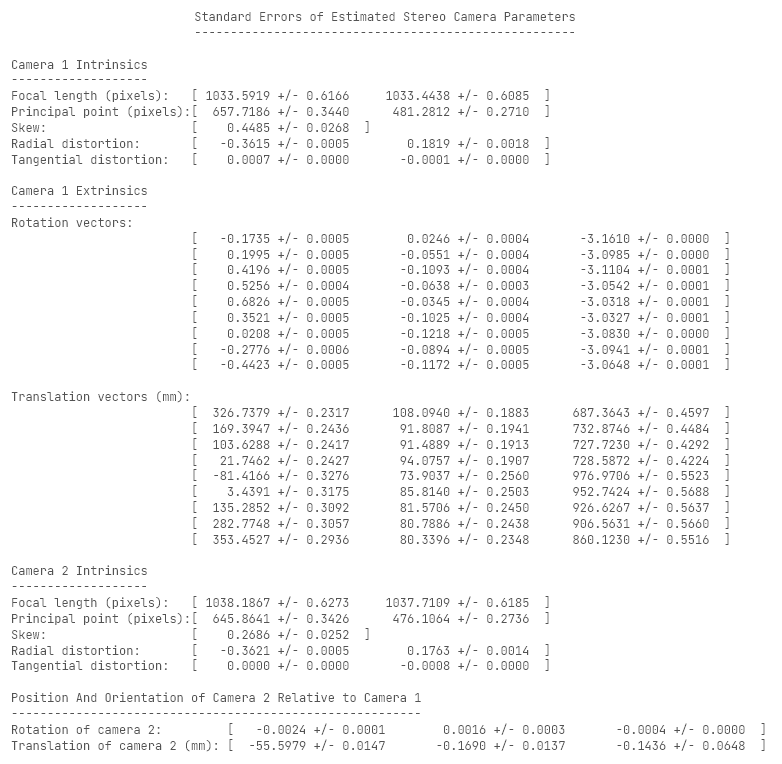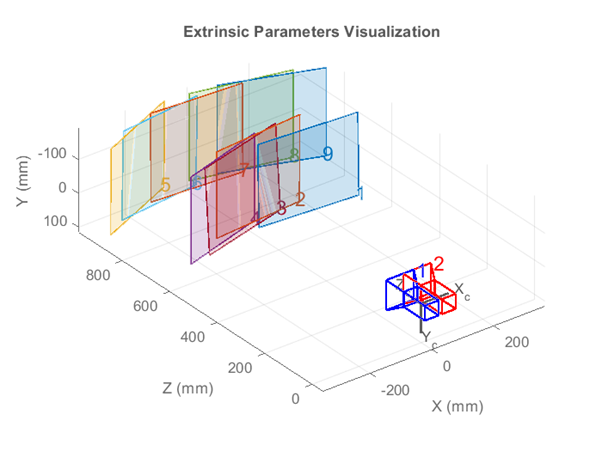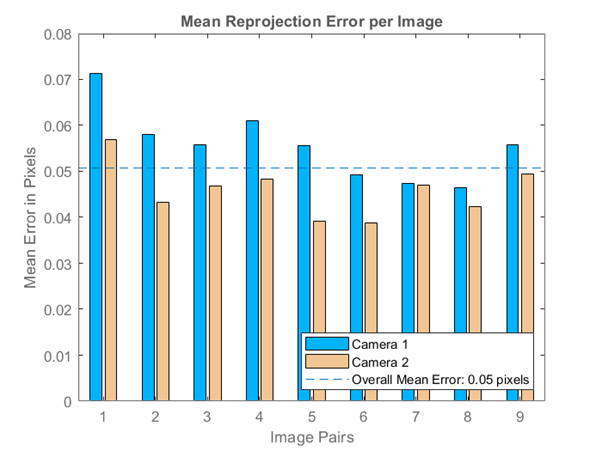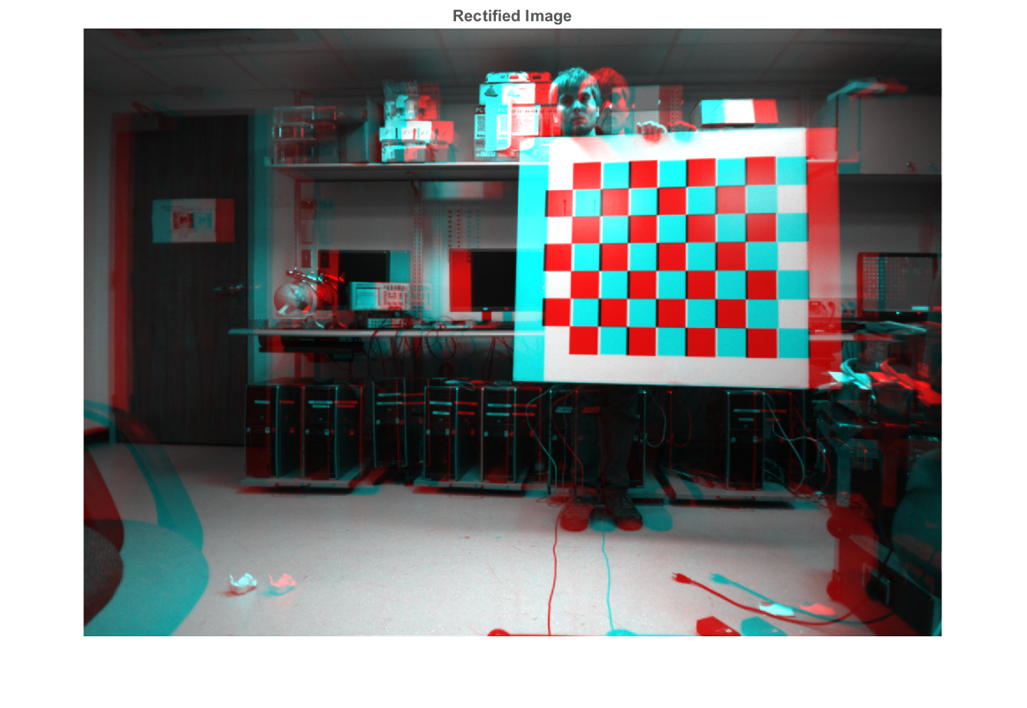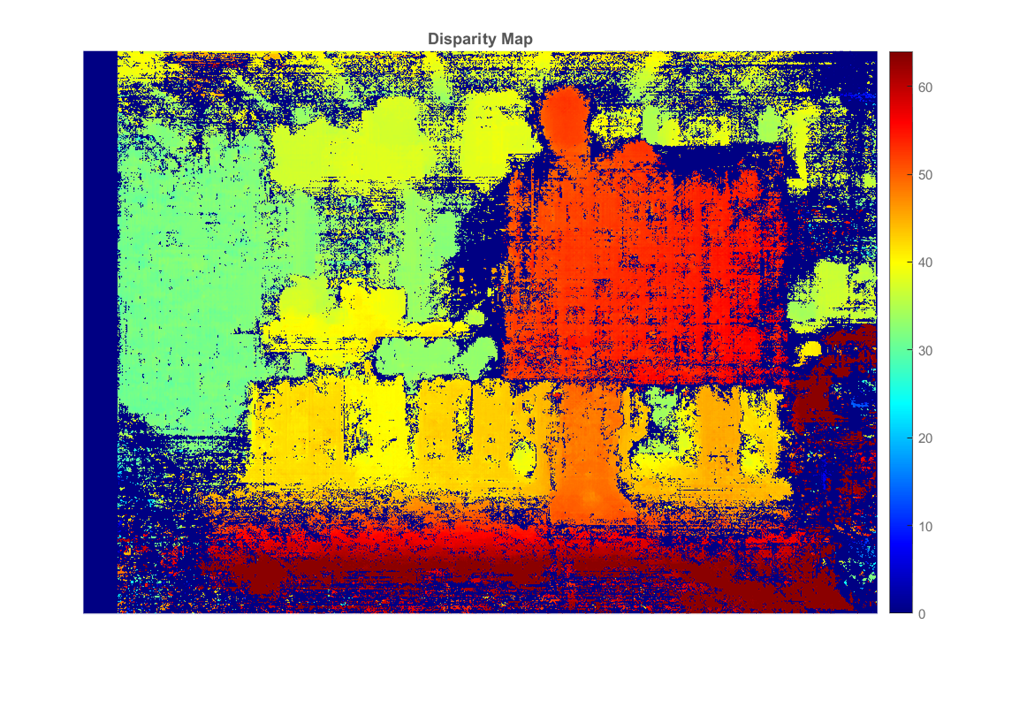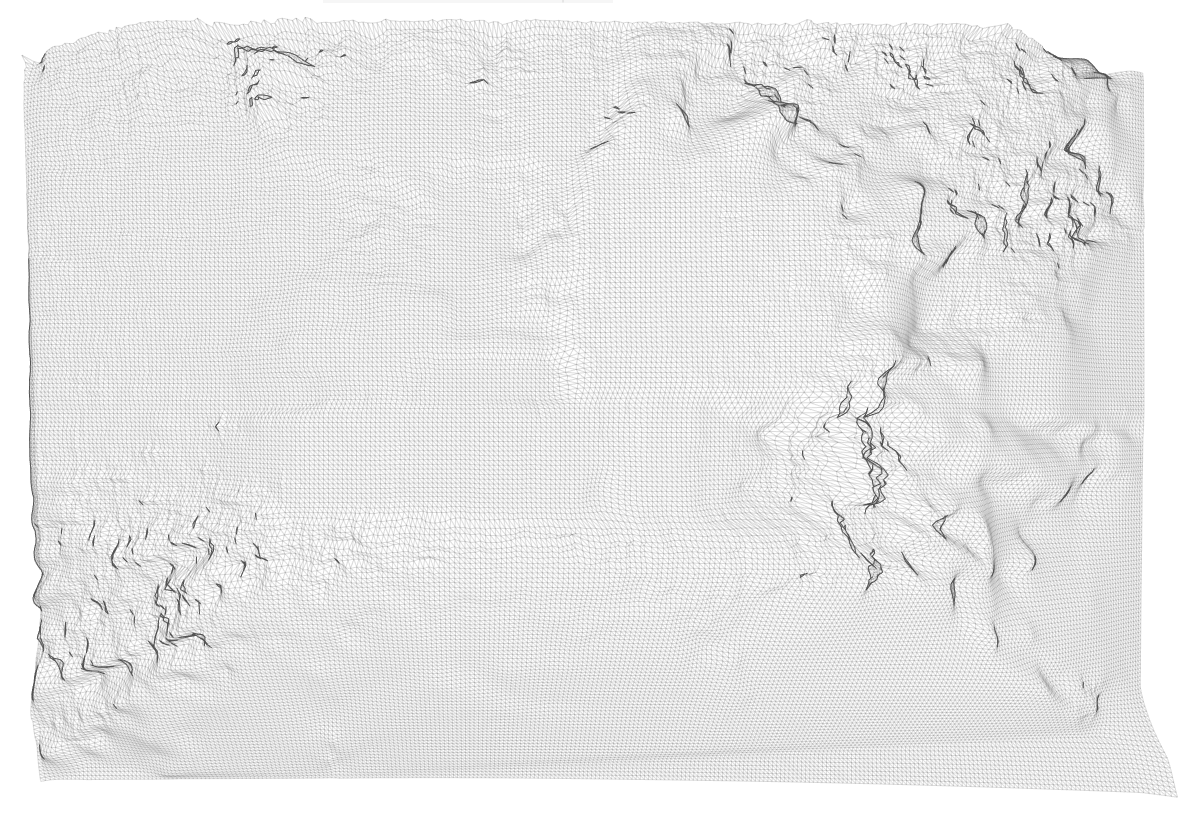Three-dimensional stereo reconstruction.
Point cloud STL generation from stereo input.
Three implementations are available depending on your use case:
script.m: a command window scriptapp.m: a GUI scriptlive.mlx: a live script
Install the mpm addon to manage dependencies automatically.
Dependency tree:
surf2stl: Write STL file from surface data.
stereo2stl is a MATLAB generator script for stereo reconstruction.
Input: landscape, JPG/JPEG, grayscale stereo images.
- Add checkerboard images from left stereo view to
./calibration/left - Add checkerboard images from right stereo view to
./calibration/right - Add modelling input images from stereo view to
./input
imformats() % supported images formats in MATLABOutput: pointCloud file in script location (STL format).
- A 3D representation of the stereo image set.
- Images should be same orientation as checkerboard to reduce pixel error from reprojection.
- For calibration images:
- asymmetric (odd-even) checkerboard should be in all views
- minimum image count per folder is 4 (for low reprojection error)
- naming convention:
./calibration/<VIEW>/<VIEW>##.jpg(e.g../calibration/left/left01.jpg)
- Image folders:
./input: actual 3D model target scene./calibration/left: left stereo view w. checkerboard./calibration/right: right stereo view w. checkerboard
Set up your image subfolders inside the same folder as script.m!
N.B: the image file names must be numbered in ascending order.
The script targets the left & right image in the ./input folder and
converts it into a STL file.
- Cleanup of MATLAB workspace, IDE & output file.
close all;
clear;
clc;- Show loading indicator.
Script takes T = ~30s to execute.
loadingWaitbar = waitbar(0, 'Loading');
loadingWaitbar.Visible = 'on';- Load surf2stl if not installed.
if ~exist('surf2stl', 'file')
if ~matlab.addons.isAddonEnabled('mpm')
error([ ...
'Please install MPM as a MATLAB Addon.\n' ...
'<a href="' ...
'https://uk.mathworks.com/matlabcentral/fileexchange/54548' ...
'">' ...
'mpm - File Exchange - MATLAB Central' ...
'</a>' ...
])
else
mpm install surf2stl;
end
end- User configuration variables.
filePath: path to current folder.stlPath: name of point cloud STL.imageMinimum: min. no of images in calib folder.squareWidthMm: Checkerboard square width in mm.ptCloudDensity: Point density within squareWidthMm.sGolayFiltOrder: Savitsky-Golay extrapolation curve order.sGolayFiltFrameLen: Savitsky-Golay sliding window point count.
filePath = fileparts(mfilename('fullpath'));
stlPath = 'point-cloud.stl';
imageMinimum = 3;
squareWidthMm = 50;
ptCloudDensity = 5;
sGolayFiltOrder = 2;
sGolayFiltFrameLen = 9;Code based on MATLAB rectifyStereoImages code sample. [1]
- Delete STL if it exists.
if exist(fullfile(filePath, stlPath), 'file')
recycle on;
delete(fullfile(filePath, stlPath));
end- Load all of our images in one go.
See "Image inputs".inputImages: Images from./inputsubfolder.calibLeftImages: Images from./calibration/leftsubfolder.calibRightImages: Images from./calibration/rightsubfolder.
inputImages = imageDatastore(fullfile(filePath, 'input'));
calibLeftImages = imageDatastore(fullfile(filePath, 'calibration', 'left'));
calibRightImages = imageDatastore(fullfile(filePath, 'calibration', 'right'));
waitbar(0.1, loadingWaitbar);- Detect the checkerboards in the original files.
[imagePoints, boardSize] = detectCheckerboardPoints( ...
calibLeftImages.Files, ...
calibRightImages.Files ...
);
waitbar(0.2, loadingWaitbar);- Calculate undistorted, real-world coordinates of checkerboard keypoints.
worldPoints = generateCheckerboardPoints(boardSize, squareWidthMm);- Read input images into MATLAB, and convert to grayscale.
This reduces image data & overhead in calibration phase. [2]
I1 = readimage(inputImages, 1);
if size(I1, 3) == 3
I1 = rgb2gray(I1);
end
I2 = readimage(inputImages, 2);
if size(I2, 3) == 3
I2 = rgb2gray(I2);
end
imageSize = [size(I1, 1), size(I1, 2)];- Image validation (for camera calibration).
Throws error if:
- mismatch in image count between
./calibration/left&./calibration/right. - below 4 images in
./calibration/left&./calibration/right. - mismatch in resolution of
./inputimages.
- mismatch in image count between
imageSize2 = [size(I2, 1), size(I2, 2)];
imageAmounts = struct;
imageAmounts.L = size(calibLeftImages.Files, 1);
imageAmounts.R = size(calibRightImages.Files, 1);
if imageAmounts.L ~= imageAmounts.R % error #1
e = sprintf( ...
'stereo2stl::ERR_MISMATCH_IMG_COUNT (L: %d, R: %d)', ...
imageAmounts.L, imageAmounts.R ...
);
errordlg(e);
error(e); %#ok<*SPERR>
elseif imageAmounts.L < imageMinimum % error #2
e = sprintf('stereo2stl::ERR_CALIB_IMG_INSUFFICIENT (%d)', imageAmounts.L);
errordlg(e);
error(e);
elseif ~isequal(imageSize, imageSize2) % error #3
e = sprintf( ...
'stereo2stl::ERR_MISMATCH_IMG_DIM (L: %dx%dpx, R: %dx%dpx)', ...
imageSize(1), imageSize(2), imageSize2(1), imageSize2(2) ...
);
errordlg(e);
error(e);
end- Use MATLAB toolbox to calibrate the stereo camera system.
- Parameters:
EstimateSkew: Are image axes exactly perpendicular? Default:true.EstimateTangentialDistortionFactor in whether the camera is horizontal. Default:true.NumRadialDistortionCoefficients: Good for fish-eye lenses. Default:2.ImageSize: Matrix for size of image -imageSize.
- TODO: Adjust
estimateCameraParametersparameters for experimental stage.
- Parameters:
[stereoParams, ~, estimationErrors] = estimateCameraParameters( ...
imagePoints, worldPoints, ...
'EstimateSkew', true, ...
'EstimateTangentialDistortion', false ...
);
waitbar(0.3, loadingWaitbar);- Display camera extrinisics for dissertation purposes.
Figure 1 & 2 - locations & reprojection errors.
Reprojection is process of "reprojecting" original image from a camera image.
Most camera images have distortion (e.g. "fisheye" lens effect).
figure;
showExtrinsics(stereoParams, 'CameraCentric');
waitbar(0.4, loadingWaitbar);
figure;
showReprojectionErrors(stereoParams);
displayErrors(estimationErrors, stereoParams);
waitbar(0.5, loadingWaitbar);- Rectify the images using "valid" output view.
The "valid" option is most suitable for computing disparity. [3]
- Parameters:
OutputView: OutputView crops the image to a rectangle, fitting inside the overlapping, curved 3D anaglyph. Default:valid.
- Parameters:
[F1, F2] = rectifyStereoImages(I1, I2, stereoParams, 'OutputView', 'valid');
pixelDensityMm = mrdivide( ...
mean([ ...
stereoParams.CameraParameters1.FocalLength, ...
stereoParams.CameraParameters2.FocalLength ...
], 2), ...
mean([ ...
stereoParams.CameraParameters1.IntrinsicMatrix(1, 1), ...
stereoParams.CameraParameters2.IntrinsicMatrix(1, 1) ...
], 2) ...
);
approxImageHeight = 2 * mean([size(F1, 1), size(F2, 1)], 2) / pixelDensityMm;
approxImageWidth = 2 * mean([size(F1, 2), size(F2, 2)], 2) / pixelDensityMm;
waitbar(0.6, loadingWaitbar);- Display an anaglyph image for "valid" output view.
Figure 3 - stereo anaglyph.
figure;
imshow(stereoAnaglyph(F1, F2));
title 'Rectified Image';
waitbar(0.7, loadingWaitbar);Code based on MATLAB disparitySGM code sample. [4]
- Compute disparity map from stereo images (colormap of depth).
disparityMap = disparitySGM(F1, F2, 'DisparityRange', [0, 64]);
waitbar(0.8, loadingWaitbar);- Display disparity map as jet colormap image.
Figure 4 - disparity map.
figure;
imshow(disparityMap, [0, 64]);
colormap jet;
title 'Disparity Map';
colorbar;
waitbar(0.9, loadingWaitbar);- Reconstruct the 3D image input into organised point cache matrix.
Produces raw point cloud of X-Y-Z data in m - standard STL dimensions.
rawPoints3D = reconstructScene(disparityMap, stereoParams);
rawPoints3D(isinf(rawPoints3D)) = NaN;
rawPoints3D = double(rawPoints3D) ./ 1000;- Initialise axial, co-ordinate cache for point cloud.
pointsCache = struct;
axesKeys = ['X', 'Y', 'Z'];
for m = 1:3
k = char(axesKeys(m));
p = rawPoints3D(:, :, m);
pointsCache.(k) = p;
end
clearvars p k;- Compute checkerboard position as a point cloud.
It's the closest set of co-ordinates to the origin in the z-axis.
TODO: See if I need to changeminin some way (assumes convex).
checkerboardCentroid.Z = min(min(pointsCache.Z));
checkerboardIndex = sort(find(checkerboardCentroid.Z == pointsCache.Z));
checkerboardCentroid.X = mean(pointsCache.X(checkerboardIndex));
checkerboardCentroid.Y = mean(pointsCache.Y(checkerboardIndex));- Restrict point cloud to following conditions:
- point cloud width/2 ~ image height
- point cloud length = point cloud height = point cloud width
limits = struct;
cacheAxes = char(fieldnames(pointsCache));
for m = 1:3
switch m
case 1
bound = approxImageWidth / 2;
case 2
bound = approxImageHeight / 2;
case 3
bound = mean([approxImageHeight, approxImageWidth], 2) / 2;
otherwise
bound = mean([approxImageHeight, approxImageWidth], 2) / 2;
end
k = cacheAxes(m);
lim = [ ...
checkerboardCentroid.(k) - bound/1000, ...
checkerboardCentroid.(k) + bound/1000 ...
];
limits.(k) = lim;
p = pointsCache.(k);
p(p < lim(1) | p > lim(2)) = NaN;
pointsCache.(k) = p;
end
clearvars k lim p;- Remove invalid (NaN) values inside point cloud.
- Values that are +/-
+Inf/-Inf/NaN. - Points that fall outside range of point cloud.
- Values that are +/-
nanPoints = ( 0 ...
| isnan(pointsCache.X) ...
| isnan(pointsCache.Y) ...
| isnan(pointsCache.Z) ...
);
for m = 1:3
k = cacheAxes(m);
p = pointsCache.(k);
p(nanPoints) = checkerboardCentroid.(k);
pointsCache.(k) = p;
end
clearvars k p;- Surface mesh denoising and interpolation.
See: https://commons.wikimedia.org/wiki/File:Lissage_sg3_anim.gif
gs = (1 / ptCloudDensity) * (squareWidthMm / 1000);
I = scatteredInterpolant(pointsCache.X(:), pointsCache.Y(:), pointsCache.Z(:), 'natural');
gridPoints = struct;
intX = min(pointsCache.X(:)):gs:max(pointsCache.X(:));
intY = min(pointsCache.Y(:)):gs:max(pointsCache.Y(:));
[gridPoints.X, gridPoints.Y] = meshgrid(intX, intY);
gridPoints.Z = I(gridPoints.X, gridPoints.Y);
intZ1 = sgolayfilt(gridPoints.Z.', sGolayFiltOrder, sGolayFiltFrameLen);
intZ2 = sgolayfilt(gridPoints.Z, sGolayFiltOrder, sGolayFiltFrameLen);
gridPoints.Z = (intZ1.' + intZ2)/2;
points3D = double.empty();
for m = 1:3
points3D(:, :, m) = gridPoints.(cacheAxes(m));
end
clearvars cacheAxes;- Convert 3D points to point cloud.
ptCloud = pointCloud(points3D);- Launch rotatable, 3D point cloud viewer.
Figure 5 - scattered point cloud.
figure;
figure3D = pcshow( ...
ptCloud, ...
'VerticalAxis', 'y', ...
'VerticalAxisDir', 'Down', ...
'MarkerSize', 12 ...
);
title '\color{black} Point Cloud';
movegui(figure3D, 'center');
figure3D.OuterPosition = [0 0 1 1];
xlabel 'x (horizontal displacement in m)';
ylabel 'y (vertical displacement in m)';
zlabel 'z (point depth in m)';
view(0, -90);
set(gcf, 'Color', 'w');
set(gca, 'XColor', 'k');
set(gca, 'YColor', 'k');
set(gca, 'ZColor', 'k');
colormap(flipud(jet));
caxis(zlim(figure3D));
colorbar(figure3D);
rotate3d on;
waitbar(1, loadingWaitbar);
close(loadingWaitbar);Using surf2stl for high stability & speed (low interpolation).
stlPath = char(fullfile(filePath, stlPath));
surf2stl(stlPath, gridPoints.X, gridPoints.Y, gridPoints.Z);winopen(stlPath);- https://www.mathworks.com/help/matlab/ref/rgb2gray.html
- https://www.mathworks.com/help/vision/examples/depth-estimation-from-stereo-video.html
- https://www.mathworks.com/help/vision/ref/rectifystereoimages.html
- https://www.mathworks.com/help/vision/ref/disparitysgm.html
- https://www.mathworks.com/help/matlab/ref/scatteredinterpolant.html
- https://stackoverflow.com/a/39576639
